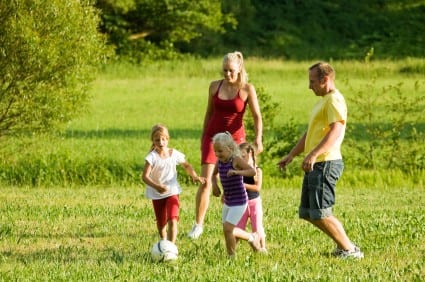Physical activity offers kids many benefits, including strong bones and muscles, weight control and a lowered risk for health problems down the road. Exercise in a child’s life also promotes an overall physically active lifestyle they can carry into adulthood. Many childhood activities involve physical activity. You don’t need a stopwatch to get an exact length of time your child exercises each day, but keep the general guidelines in mind if you’re concerned about your child’s activity level.
Variety is Key
A variation in the type of exercise helps your child work on different muscle groups and achieves different goals. Kids Health recommends endurance, strength and flexibility activities. Many kids achieve these types of exercise during free time, such as recess or outdoor play. For example, during a game of tag or basketball they work on their endurance. A balance of active free play and organized physical games and activities helps your child get a well-rounded dose of exercise each day.
Toddlers
Toddlers who are 2 or older need about 1 1/2 hours of physical activity each day. This might include about 30 minutes of organized physical games and activities in addition to an hour of free playing that is physical in nature. This could include running around the park or playing with balls in the backyard. There are no general guidelines for children under the age of 2, but you can encourage your infant to be active by playing with age-appropriate toys.
Preschoolers
As children near the preschool age, the National Association for Sport and Physical Education recommends two hours of daily physical activity. One hour is spent on structured physical activities, with the other hour being used for active free play. Both toddlers and preschoolers should stay active throughout the day, with at least some physical activity every hour.
School Age
At least an hour of physical activity each day is ideal for school-aged children and older. Many school-aged children already have physical activities built into their day. Physical education is a part of most school programs at least a few times per week. Check with your child’s teacher to figure out how much time is spent in gym class. If your child runs around and stays moderately active during recess, this time counts toward the daily total. Other children participate in organized sports, such as soccer teams or dance class.
What You Can Do
Your child doesn’t need to fit in all of his exercise in one long stretch. Try breaking up the exercise time into chunks of at least 15 minutes throughout the day. Limiting time in front of the television or video games encourages your child to find other ways to spend his time. You can also help your child meet his daily exercise recommendations by planning active family time, such as a walk around the neighborhood or a hiking trip.





